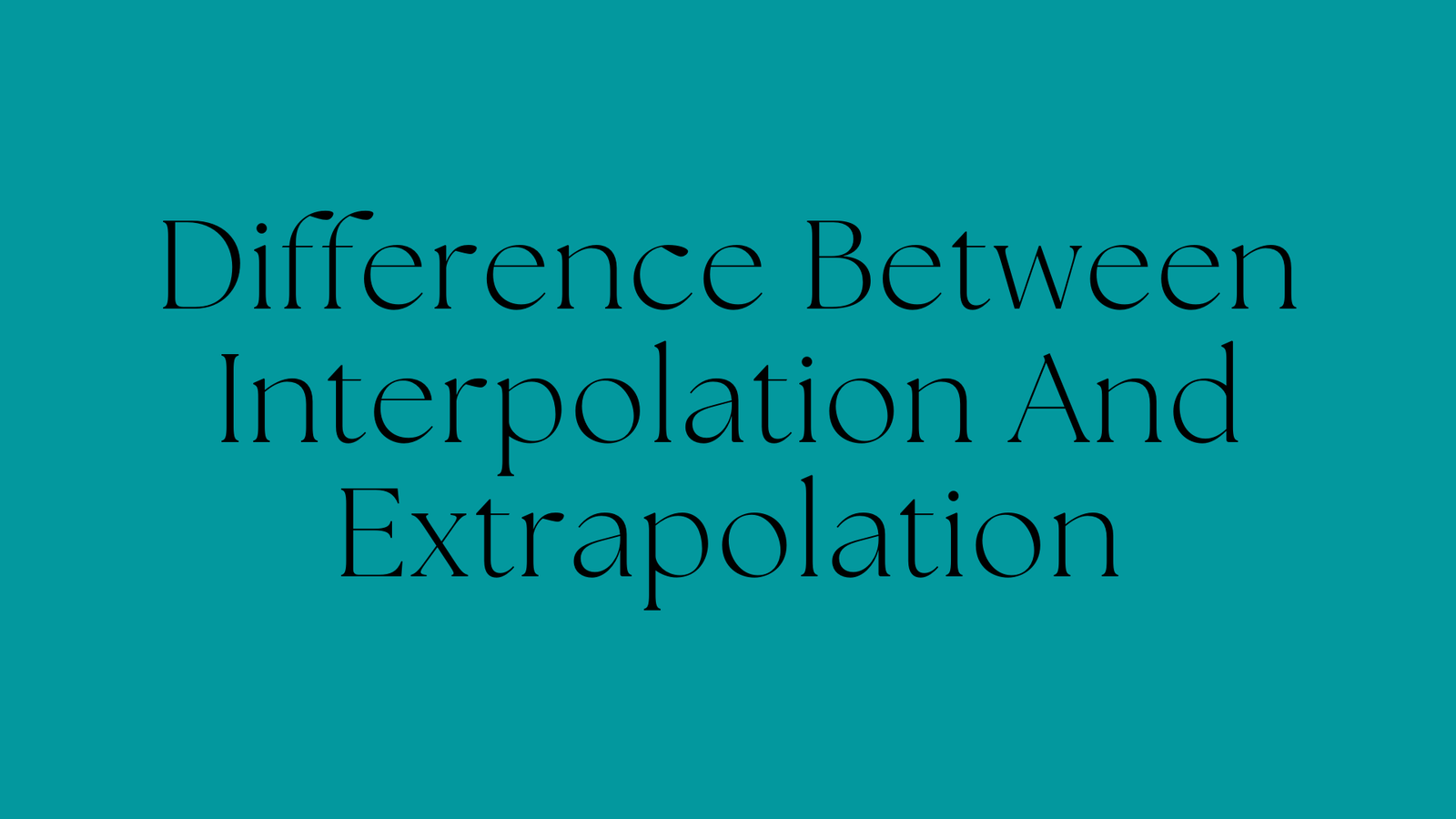Difference Between Interpolation And Extrapolation: Extrapolate vs. Interpolate

Difference Between Interpolation And Extrapolation: Extrapolate vs. Interpolate
Introduction
Mathematical techniques are used in many different fields to analyze data and create predictions.
Interpolation and extrapolation are two popular types of prediction, and each can be performed in a variety of ways.
If you work in math, statistics, engineering, or any data-related field, understanding what interpolation and extrapolation are, how they differ, and when to apply each form of prediction might be beneficial.
In mathematics, there are two types of prediction: interpolation and extrapolation. Although interpolation and extrapolation seem similar and are both strategies for estimating hypothetical values, they serve different objectives and are effective in various situations.
Extrapolation is used to forecast values that fall outside of a data set and uses known values to predict unknown values, whereas interpolation is used to predict values that exist within a data set.
Interpolation is often more trustworthy than extrapolation, yet both methods of prediction can be useful for different reasons.
There are numerous methods for performing interpolation and extrapolation, including linear and polynomial prediction algorithms.
Interpolation and extrapolation are frequently performed by drawing lines or curves on graphs or by employing well-known functions.
Both interpolation and extrapolation have many real-world applications and examples in domains such as mathematics, science, statistics, and finance.
What is interpolation?
Interpolation is possibly more widely employed in math and data science. In this meaning, interpolation is the process of calculating the value of a function depending on the values of other points.
In other words, an unknown value inside the sequence is determined by what else is in the sequence. The process of determining a value in this manner is known as interpolating.
Interpolation methods that are commonly used include:
- Linear interpolation: Linear interpolation is one of the most basic interpolation algorithms. To find the other values in a data set, you simply draw a straight line between points on a graph in linear interpolation.
- Polynomial interpolation is a type of interpolation that involves applying polynomial functions to estimate values within a gap in a data set on a graph.
- Spline interpolation: Spline interpolation estimates the values that fill gaps in data sets using piecewise functions. Spline interpolation can be more trustworthy than polynomial interpolation in some cases.
For example, imagine you’re looking at a line on a graph with a gap between data points. By drawing a line or curve between existing points and utilizing interpolation, you can readily picture which point fills the gap.
Interpolation is frequently favored over extrapolation because the estimate obtained by interpolation is more likely to be correct.
What is extrapolation?
Extrapolation is a way of estimating hypothetical values that fall outside of a data collection.
Extrapolation in math and data science refers to estimating the value of a variable or function outside of an observable range.
So, to offer a very basic example, if a sequence of values contains 2, 4, 6, and 8, you may assume that the following value would be 10 if the curve continued in the same manner.
That’s extrapolation: you don’t know what the value will be with certainty, but you can make an educated guess based on what you know about the sequence’s nature (or the trajectory of the curve).
Extrapolation techniques that are commonly used include:
- Linear extrapolation: Linear extrapolation, like linear interpolation, involves drawing lines or applying linear functions to forecast values outside of a given data set.
- Polynomial extrapolation: Polynomial extrapolation is the process of estimating values on a graph by applying polynomial forms and functions.
- Conic extrapolation: Conic extrapolation is the use of conic sections with known data to extrapolate unknown data.
Consider extrapolation on a graph. Consider a function graph with a set of plotted points. You can extrapolate the function by drawing a line or curve between two points, or by utilizing the shape of a commonly used function, such as parabolas or hyperbolas.
Outside of mathematics, the phrase extrapolation refers to forming an assumption based on the information provided. Extrapolation is riskier than interpolation, thus it must be done with caution.
Difference between interpolation and Extrapolation
The differences are explained below.
Explanation
Interpolation: Interpolation is a statistical approach for estimating unknown values from known ones.
The unknown value is typically located between two known values and may appear to be the midpoint between the two known positions.
Extrapolation is a statistical approach for predicting unknown values at points outside of the range of the recorded data. It is used to expand a known series of values beyond the area sampled.
Obtaining the unidentified value
Interpolation: this method is used to obtain the unknown value(s) between two known values. As a result, the predicted value falls within the scope of the sampled area.
Extrapolation: This statistical procedure obtains unknown data from outside the sampled area. The chosen point may be either above or below the known positions.
Predictions
Interpolation is a strategy that is commonly used to forecast data and values within a range. We may be confident that our forecasts are reasonable when using this method because their values are calculated inside the sampled area.
Because true or close values are required during curve fitting, the interpolation method may be more accurate than other methods.
Extrapolation: When employing Extrapolation, we can be less sure in the unknown values that are produced.
The approach incorporates values from outside the sampled area, causing the predictions to deviate from the genuine values. This approach is not recommended for curve fitting.
The possibility of obtaining a negative
Interpolation: The interpolation approach is incapable of retrieving negative responses. This is due to the fact that it does not permit the inclusion of values outside of the range.
This precludes it from being used in several statistical calculations that necessitate extrapolation.
Extrapolation: one feature that distinguishes it from interpolation is the ability to get negative responses.
This statistical method allows you to move the data in the range ahead or backward in time. The negative values are obtained by this technique of extending values.
The values required to carry out each procedure
Interpolation: As previously explained, this technique is based mostly on two known values. It only works when there are two points and the unknown value is found between them.
Let’s imagine we have two points that are 4 and 8. Then, our unknown value may be calculated.
Extrapolation: is a technique that only requires one known value. That is, either the higher or lower number. The unknown value is then projected either forward or backward from this number.
Data Capacity
Interpolation: this technique has a set amount of data it can handle. You must only work with data/values that fall within the specified range. This can be a problem if you want to introduce a value that is outside of the range.
Extrapolation: There is no predefined data limit in this statistical procedure. As a result, the user can extrapolate the given value and introduce values outside of the range, which can be useful when working with numbers outside of the range.
Finally, it can be observed that the two techniques differ substantially and that each method is valuable in its own manner.
When should you use interpolation versus extrapolation?
Although interpolation and extrapolation sound similar, each type of prediction has diverse applications. Interpolation is often deemed less dangerous than extrapolation, hence it is worthwhile to use interpolation in high-stakes scenarios.
Furthermore, utilize interpolation when predicting a value that exists within a set of data points, and extrapolation when predicting a value that exists outside of a group of data points and using known values to forecast an unknown value.
Application of interpolation and extrapolation
There are several real-world instances and professional applications of interpolation and extrapolation, such as:
Mathematics
Interpolation and extrapolation have several applications in mathematics, and it is critical for mathematicians to grasp both types of prediction.
Interpolation and extrapolation are often employed in mathematics to derive functions from graphs and locate unknown values in data sets.
Science
Interpolation and extrapolation have a wide range of real-world applications in science. You could, for example, use interpolation and extrapolation to build models that anticipate the weather or estimate unknown chemical concentration values.
Because the field of science frequently requires data analysis, understanding interpolation and extrapolation is particularly useful if you work in this job field.
Statistics
Interpolation and extrapolation are also used extensively in statistics. Statistics is a science that centers around data collection, analysis, and prediction, making interpolation and extrapolation vital skills for statisticians.
Statisticians frequently use extrapolation to assist determine unknown data from existing data. Extrapolation can also assist statisticians use previous data to forecast future data, such as estimating population increase based on historical population data.
Finance
Because the primary goal of interpolation and extrapolation is to anticipate values, both prediction methods can be useful in the subject of finance.
Financial analysts, for example, could utilize interpolation and extrapolation to create forecasts about financial data to assist their firms in budgeting and planning for the future.
Interpolation and extrapolation could potentially be used by financial experts to assess the stock market and make wise bets.
FAQs
What is extrapolation?
Extrapolation is a way of estimating hypothetical values that fall outside of a data collection.
What is interpolation?
Interpolation is a statistical strategy for estimating an unknown price or possible yield of an asset using related known variables.
Interpolation is accomplished by employing other proven values that are positioned in the same sequence as the uncertain value. Interpolation is fundamentally a mathematical notion.
Is it better to interpolate or extrapolate?
Extrapolation is used to forecast values that fall outside of a data set and uses known values to predict unknown values, whereas interpolation is used to predict values that exist within a data set.
Interpolation is often more trustworthy than extrapolation, yet both methods of prediction can be useful for different reasons.
Why is it safer to interpolate than to extrapolate?
Interpolation is the preferable method of the two. This is because we have a better chance of getting a valid estimate. When we utilize extrapolation, we are assuming that our observed trend will continue for x values outside of the range we used to create our model.
What is the difference between interpolation and extrapolation?
Interpolation is the statistical technique of predicting a value that exists within the range of data points. In contrast, extrapolation is used to predict values that fall outside of a data set.
Interpolation and extrapolation real life applications?
Interpolation is used in numerous areas such as economics and mathematical proofs. The most significant amount of interpolation is found in financial applications, where it is very helpful in forecasting values such as interest rates.
In mathematics, interpolation is used to find the length of a rectangular line from the x and y coordinates that give its location.
How is interpolation used in science and math?
In science, interpolation is used to find an unknown value. In this case, data points that are the same but slightly different from the unknown data point can be used to estimate that value.
In math, interpolation is used to find the length of a rectangular line from the x and y coordinates that give its location. This method can be accomplished using either linear or nonlinear interpolation.
Why do we use interpolation?
In a nutshell, interpolation is the process of discovering unknown values that exist between known data points. It is mostly used to forecast unknown values for geographical data points such as noise level, rainfall, elevation, and so on.
Why is extrapolation inaccurate?
So, what’s the problem with extrapolation? For starters, it is difficult to model the past. Second, it is difficult to predict if a model from the past can be applied to the future.
Deep problems regarding causality or ergodicity, the sufficiency of explanatory variables, and so on lurk underneath both assertions.
What is GIS interpolation?
Spatial interpolation is the technique of estimating values at other sites by using points with known values. In GIS applications, spatial interpolation is often applied to a raster, with estimates made for all cells.
Spatial interpolation is thus a method of generating surface data from sample locations.
What do you mean by inverse interpolation?
Inverse interpolation is the process of determining the value of the independent variable x for a given value of y falling between two tabulated values using a given set of observations for an unknown function.
How do you extrapolate differences?
Take the money worth of the deviations (or other sample result) and divide it by the dollar value of the overall sample to compute the POE. Then increase that POE by the population’s monetary value.
What are the assumptions of interpolation and extrapolation?
The following assumptions are used in interpolation and extrapolation: There are no abrupt changes in the values of the dependent variable (Y) from one period to the next (X).
The rate of change in figures (Y) from one era to the next (X) is constant. There will be no missing values in the series that are consecutive.
When to use interpolation and extrapolation?
Interpolation and extrapolation are useful when attempting to estimate values outside of a data set.
As an example, we may need to estimate the amount of rainfall in a given year based on previous annual rainfall figures.
Interpolation is used for values that exist within the range of observed data, whereas extrapolation forecasts values that exist beyond the observed range.

